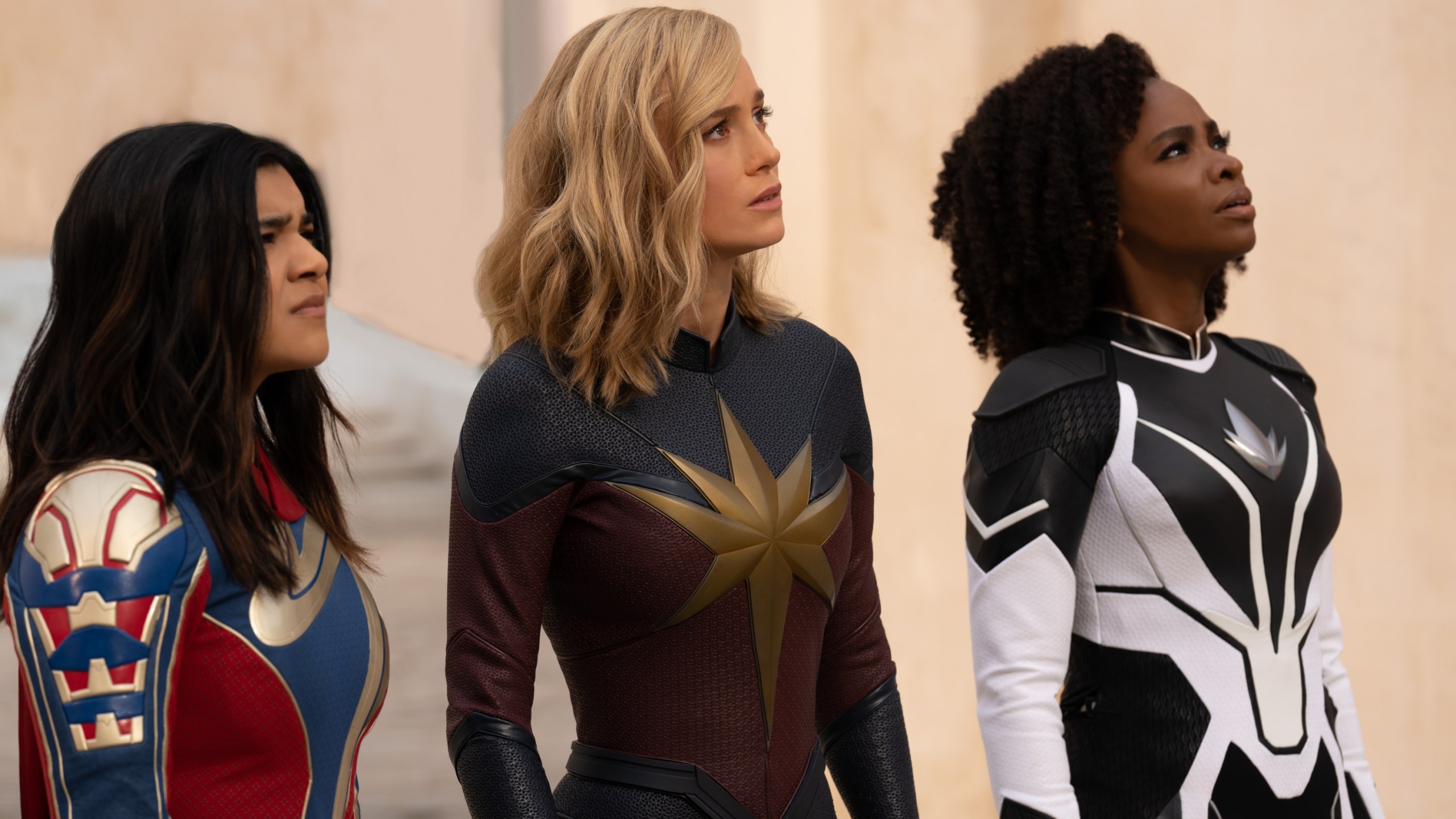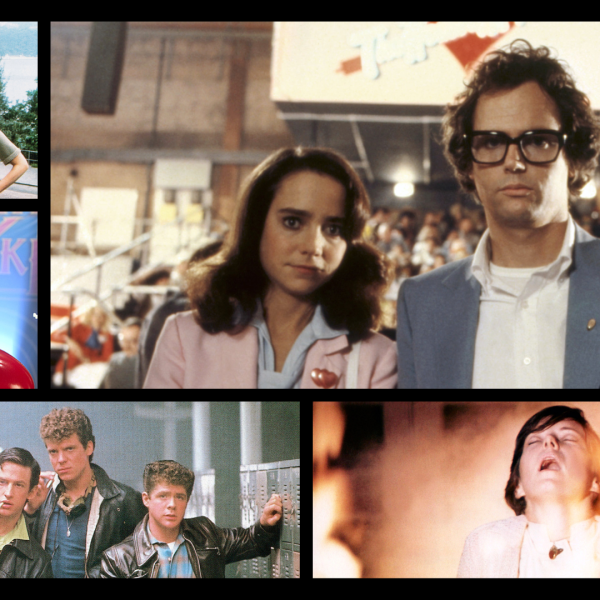After sinking at least 100 hours of my life over the last 15 years into watching all the Marvel Cinematic Universe films and some of the shows (to say nothing of any subsequent rewatches), there is something truly discomfiting about sitting in a massive IMAX theater to watch the newest Marvel film and the best scribble I can make in my critic’s notebook is “???”
At this point, it comes with the territory. Anyone unable to watch every single piece of Marvel-made content before catching the latest project must resign themselves to not getting every reference these days, or even most of them. We’re talking a staggering array of 33 feature films, 12 series (including over 400 total episodes), various post-credits scenes, a handful of short films, and more.
Tellingly, the most pleasurable moments in Nia DaCosta’s “The Marvels” don’t hinge on the audience having an encyclopedic knowledge of all things Marvel. Hell, they don’t even hinge on the audience being particularly inclined toward anything Marvel. They’re just solid pieces of blockbuster filmmaking: charming stars (like the full-force charisma of Iman Vellani and the appealing vulnerability of Teyonah Parris), sprightly action, and zippy humor.
But as good as those elements are, when stacked up inside an otherwise scattered, choppy, and often incoherent film, they also feel like stinging reminders of what could have been (a better film) and what needs to happen now (a total MCU reset). There are long stretches in “The Marvels” in which I had no idea what was going on, perhaps because I’m (somehow) not up on every Marvel machination, but likely because the film feels edited and snipped and trimmed within an inch of its life. Moment to moment, scene to scene, beat to beat, there are — there have to be — promising patches of cut material on an editing bay floor somewhere.
Much has been made of the film’s relatively slim (at least by Marvel standards) running time, with DaCosta’s film clocking in at 105 minutes, making it the shortest MCU film ever (runner-up: “The Incredible Hulk,” which is 112 minutes long), and while that base number might feel like a relief to some (me included), if there is a coherent cut of “The Marvels” that’s twice as long, I beg to see it.
As is, “The Marvels” picks up long after the first “Captain Marvel” film (assorted flashbacks to the 2019 feature do little to clear up any lingering confusion about how it all fits together) and requires a working knowledge of Marvel TV shows including “WandaVision,” “Ms. Marvel,” and “Secret Invasion.” Sound like homework? It’s so much worse than that.
In the world of “The Marvels,” Captain Marvel, aka Carol Danvers (Brie Larson), is still zipping through space, all the better to be available to save any alien planets or people that need assistance. Her niece Monica (Parris; a running gag is that her Captain Rambeau is totally opposed to getting her own flashy nickname) is working hard for Nick Fury’s (Samuel L. Jackson, who somehow seems to have forgotten how to play this part) S.A.B.E.R. while plucky young Ms. Marvel, aka Kamala Khan (Vellani), is still figuring out how to live up to being “the hero of Jersey City.”

When Kree baddie Dar-Benn (Zawe Ashton) digs up a “quantum band” (better known as one half of the powerful bangle set that Kamala wears) on some far-flung, green-screened-to-hell planet, the energy it emits when paired with the “Universal Weapon” (have we really run out of names for things?) is enough to shake up the various jump points that allow those in the know (like Carol, Monica, Nick, and Dar-Benn) to bounce between universes and galaxies with ease.
More than that, however, the energy Dar-Benn unleashes also connects Carol, Monica, and Kamala — flimsy excuses and limp rules are rolled out to explain all this away — and “entangles” their powers, to the point that any time the superheroes use them, they get “swapped” with one of the other two fellow Marvels. Said swapping does allow for some amusing and unique action sequences and DaCosta turns in some of the most original the MCU has seen in many years. Carol cycles into Kamala’s house (where her delightful family reacts in the exact way you’d expect normal people to respond to such insanity), Monica ends up face-to-face with Dar-Benn’s big plan, and Kamala believes the whole thing is some test to become an Avenger.
Soon enough, the trio figure out (sort of?) what’s afoot and who’s to blame. As they head out into space to face off with Dar-Benn, who has been busy engaging in everything from genocidal terrorism to environmental resource theft (fun for the whole family!), the unexpected new team is pushed to work together to, eh, save the universe or something (it’s always the universe that needs saving).

As primary big bad Dar-Benn, Ashton must embody yet another wholly forgettable and totally interchangeable Marvel villain. She’s a righteously pissed-off warrior whose backstory hinges on some very spotty flashbacks to reveal her connection to Carol and her motivations for hitting the superhero where it hurts (or something?). But while Dar-Benn’s aims might feel murky (to say nothing of her ponytailed sidekick whose name we never learn and who is forgotten halfway through the film, like so much else), Ashton’s appearance in the film hints at one pleasant subplot: In real life, the lauded British actress is the fiancee of Tom Hiddleston, Loki himself, so clearly the franchise’s best baddie is still invested enough in all of this to encourage the mother of his child to join the fray. That’s nice, right?
Hunting for other “nice” moments in “The Marvels” will only churn up similar confusion. There are bits that seem designed for maximum fun (and, are probably the product of reshoots that demanded said fun in an otherwise baffling outing). These include a sequence in which the trio practice swapping their powers, a jaunt to a far-flung planet that turns into a dizzy musical diversion, and even the single most bonkers set piece the MCU has ever churned out, featuring original music from the musical “Cats” — but it all feels like padding.
And while I might feel inclined to shout, “Where is the rest of this film?!” into a void for the foreseeable future, the worse answer beyond “it was edited out because of whatever” is that there is no rest of this film, that Marvel’s obsession with serialized storytelling on a monster scale has left its films entirely unable to exist on their own merits.

Marvel’s eternal promise is that this all fits into some greater world, some larger framework, a planned overarching universe and it’s one that Marvel has failed to deliver since the conclusion of “Avengers: Endgame.” Reorienting the franchise after literally splintering the entire universe and bringing it back together is not an enviable task, but Marvel brass have proven to be stubbornly resistant to turning their attention to new characters, fresh stories, and a world where the fate of everyone and everything isn’t constantly hanging in the balance.
But that’s not the problem with “The Marvels.” This film actually attempts to be new and fresh — Vellani and Parris have enough charm to power 10 more films, and the “wacky” moments that pepper this one are welcome respite that show real originality from DaCosta — but it’s all ripped away for more of the same. That “same”? It’s not working anymore, and if “The Marvels” shows us anything, it’s a fleeting glimpse of what the MCU could look like, if only it was superheroic enough to try.
Grade: C-
Walt Disney Pictures will release “The Marvels” in theaters on Friday, November 10.



